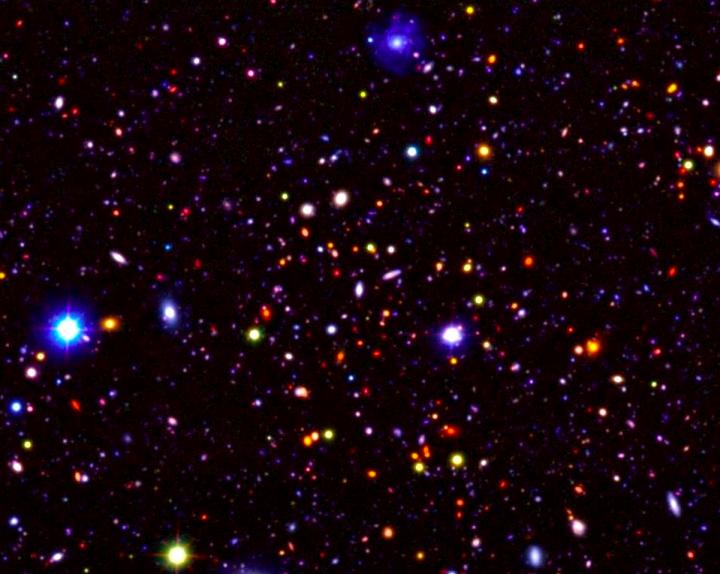Astronomers release spectacular survey of the distant universe

An image of a small section (0.4 percent) of the UDS field. Most of the objects in the image are very distant galaxies, observed as they were over 9 billion years ago. In the full image, 250,000 galaxies have been detected over an area of sky four times the size of the full moon. Please credit: Omar Almaini, University of Nottingham.
The final data release from the Ultra-Deep Survey (UDS) maps an area four times the size of the full Moon to unprecedented depth. Over 250,000 galaxies have been detected, including several hundred observed within the first billion years after the Big Bang. Astronomers around the world will use the new images to study the early stages of galaxy formation and evolution.
The release of the final UDS images represents the culmination of a project that began taking data in 2005. The scientists used the United Kingdom Infrared Telescope (UKIRT) on Hawaii to observe the same patch of sky repeatedly, building up more than 1,000 hours of exposure time. Observing in the infrared is vital for studying the distant Universe, as ordinary starlight is “redshifted” to longer wavelengths due to the cosmological expansion of the Universe.
Because of the finite speed of light, the most distant galaxies are also observed very far back in time.
Professor Almaini, said: “With the UDS we can study distant galaxies in large numbers, and observe how they evolved at different stages in the history of the Universe. We see most of the galaxies in our image as they were billions of years before the Earth was formed.”
The UDS is the deepest of five projects, collectively known as the UKIRT Infrared Deep Sky Survey (UKIDSS).
Earlier releases of data from the UDS have already produced a wide range of scientific advances, including studies of the earliest galaxies in the first billion years after the Big Bang, measurements of the build-up of galaxies through cosmic time, and studies of the large-scale distribution of galaxies to weigh the mysterious 'dark matter' that pervades the cosmos. The added depth from the new release is expected to produce many new breakthroughs.
Dr David Maltby, a postdoctoral research fellow at The University of Nottingham whose research focusses on morphological evolution of galaxies, said: “Here in Nottingham we are aiming to understand how galaxies evolved to produce the rich diversity we see today. For example, we still don't understand why the most massive galaxies are usually elliptical in shape, while less massive galaxies tend to be disk-shaped with spiral arms. By looking back in time to the early Universe we can catch these galaxies in their infancy, and observe them as they change and evolve over many billions of years.”
###
Images are available.
An image of a small section (0.4 per cent) of the UDS field. Most of the objects in the image are very distant galaxies, observed as they were over 9 billion years ago. In the full image, 250,000 galaxies have been detected over an area of sky four times the size of the full Moon.
http://www.
Please credit: Omar Almaini, University of Nottingham.
UKIRT
The 3.8-metre United Kingdom Infrared Telescope (UKIRT) is the world's second largest telescope dedicated to infrared astronomy. UKIRT is sited near the summit of Mauna Kea, Hawaii, at an altitude of 4,194 metres (13,760 feet) above sea level. The telescope was owned and operated by the UK Science and Technology Facilities Council until 2014, when ownership transferred to the University of Hawaii.
UKIDSS
The UKIRT Infrared Deep Sky Survey (UKIDSS) is a large astronomical project that began in 2005, using most of the available observing time on the United Kingdom Infrared Telescope (UKIRT). UKIDSS consists of 5 separate surveys, from shallow mapping of large areas of sky to deeper studies of the distant Universe. The UDS is the deepest of the UKIDSS surveys.
Media Contact
All latest news from the category: Physics and Astronomy
This area deals with the fundamental laws and building blocks of nature and how they interact, the properties and the behavior of matter, and research into space and time and their structures.
innovations-report provides in-depth reports and articles on subjects such as astrophysics, laser technologies, nuclear, quantum, particle and solid-state physics, nanotechnologies, planetary research and findings (Mars, Venus) and developments related to the Hubble Telescope.
Newest articles

Trotting robots reveal emergence of animal gait transitions
A four-legged robot trained with machine learning by EPFL researchers has learned to avoid falls by spontaneously switching between walking, trotting, and pronking – a milestone for roboticists as well…

Innovation promises to prevent power pole-top fires
Engineers in Australia have found a new way to make power-pole insulators resistant to fire and electrical sparking, promising to prevent dangerous pole-top fires and reduce blackouts. Pole-top fires pose…

Possible alternative to antibiotics produced by bacteria
Antibacterial substance from staphylococci discovered with new mechanism of action against natural competitors. Many bacteria produce substances to gain an advantage over competitors in their highly competitive natural environment. Researchers…





















